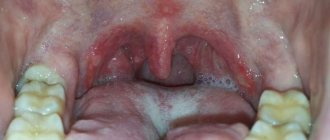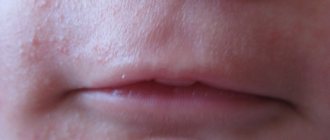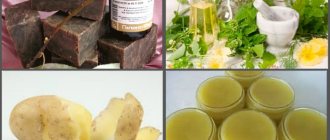Causes of viral stomatitis in children
There are several causes of viral stomatitis in children. This:
- recent infectious diseases: herpes (80% of cases), influenza, adenoviral infections, measles, chicken pox;
- contact with a sick person: a viral type of stomatitis is transmitted by airborne droplets, as well as through some objects (toys, dishes, personal hygiene items, etc.);
- weak immunity.
Viral herpes in children is one of the most common forms of damage to the oral mucosa. This can be explained by the fact that babies are very sensitive to the herpes virus, and if one of the family members gets herpes, there is a high probability that the child will develop stomatitis.
Treatment with traditional methods
Along with pharmaceutical drugs, folk remedies can also be used for treatment. To relieve inflammation, decoctions prepared from medicinal herbs are recommended. You can use herbs such as:
- series;
- chamomile;
- sage;
- calendula.
Propolis is an effective remedy in the treatment of any type of stomatitis. To prepare rinses, you can purchase an alcohol tincture of this substance at the pharmacy. Dilute a teaspoon of tincture with half a glass of water and gargle.
If it is possible to obtain pure propolis, it can be used for chewing. In the acute phase of stomatitis, you need to take 20 grams of pure propolis and chew it slowly. As symptoms subside, the dose is reduced to 5 grams per day.
Fresh aloe juice helps a lot in treatment. To prepare the medicine, you need to squeeze the juice from the lower fleshy leaves, dilute it with water and use it for rinsing. Pure juice can be used to lubricate rashes where you can get them.
You can also gargle with stomatitis with carrot juice. This product contains substances that speed up the healing process of ulcers. Only freshly prepared juice should be used; it should be diluted in half with water. Similarly, you can use freshly prepared juice squeezed from white cabbage leaves.
So, stomatitis can manifest itself as rashes not only in the oral cavity, but also on the tonsils. The disease can be caused by both bacteria and the herpes virus. Therefore, treatment for this disease can only be prescribed by a specialist after testing.
Symptoms
- The child becomes nervous, capricious, lethargic, whiny, refuses to eat and sleeps poorly.
- With viral stomatitis, children sometimes develop a fever.
- The child complains of severe pain in the mouth, the submandibular lymph nodes are painful when pressed.
- There is an unpleasant odor from the mouth.
- When examining the oral cavity, you can see that the gums are swollen and bleeding, and ulcers (aphthae) have appeared on the tongue and mucous membranes - at first they resemble pimples, then they become covered with a whitish film.
Viral stomatitis in children is dangerous because at the initial stage its symptoms resemble a sore throat: the child has difficulty swallowing, complains of pain in the mouth, and upon examination the throat looks swollen. And if you self-medicate, you can ensure that dental aphthae will spread further. Only a specialist can make an accurate diagnosis.
Sore throat (acute tonsillitis)
Symptoms
The leading symptom is a sore throat, especially when swallowing and eating. The intensity of the pain syndrome can vary from quite tolerable to severe. The severity of symptoms of general intoxication (increase in body temperature from 37°C to 40°C or more, weakness, general malaise, headache, loss of appetite, sleep disturbances, enlarged and painful regional lymph nodes) and local inflammation in the tonsils also varies in different cases ( swelling, hyperemia).
The most typical, common manifestations of acute tonsillitis are listed above. Other symptoms may differ so significantly that this serves as the basis for identifying several relatively independent clinical forms.
Catarrhal sore throat is the most common and, fortunately, the least severe form. It manifests itself as a burning sensation, a “soreness” in the throat, drying out of the mucous membranes of the oropharynx, a coated tongue, and moderate pain when swallowing. As a rule, the syndrome of infectious intoxication occurring against the background of low-grade fever has an asthenic component. A mucopurulent coating may appear on the tonsils. With a sufficient immune response, symptoms are reduced within a few days.
Follicular tonsillitis , also very common, usually manifests itself with high fever, sharp radiating pain in the throat, severe clinical intoxication, a feverish state (up to symptoms of depression of the central nervous system), gastrointestinal disorders, and vomiting. Multiple suppuration of small follicles gives the tonsils a characteristic “starry sky” appearance; spontaneous opening leads to accumulations of pus. The active phase of the disease lasts about a week.
Lacunar tonsillitis is, in fact, a more severe version of follicular tonsillitis. Muscle and joint pain and cardialgia are often added. Tonsils, as a rule, are covered with purulent plaque in the form of films.
Fibrinous tonsillitis , in turn, can be considered as the next phase in the development of lacunar tonsillitis: a continuous yellow-white coating forms, covering not only the tonsils, but also adjacent areas.
Phlegmonous tonsillitis is characterized by a widespread, diffuse purulent-inflammatory process in the parenchyma of the tonsil (usually one of the two). The muscles of the temporomandibular joint often spasm. The current is severe.
Gangrenous tonsillitis (Vincent's ulcerative-necrotizing tonsillitis, see above) is characterized by massive death of cells in the affected tonsil, putrid breath, deep ulceration with the formation of defects due to purulent melting of the tissue. Body temperature in most cases remains moderately elevated or normal.
Herpetic (viral) tonsillitis occurs more often in children, is distinguished by a particularly acute onset and high contagiousness, polymorphic severe symptoms (including from the gastrointestinal tract), which, however, are quickly reduced. The tonsils are covered with small red, inflamed blisters.
As is often the case in medical practice, the prevalence and fame of the disease does not at all guarantee against severe complications. The dynamics of acute tonsillitis can result in an intra- or peritonsillar abscess, trigger the start of a rheumatic process, glomerulonephritis; the rapid spread of infection in some cases results in meningitis or secondary inflammation of another localization, as well as life-threatening infectious-toxic shock or sepsis.
Treatment of viral stomatitis in children
The course of treatment for viral stomatitis in children depends on the timeliness of visiting a doctor, as well as the age and state of the child’s immunity. It may include:
- Rinse
As a rule, the dentist recommends treating the mucous membranes of the oral cavity with anti-inflammatory drugs. Also, for viral stomatitis in children, you can use decoctions of certain plants (calendula, chamomile, sage) or an infusion of oak bark. For small children who do not know how to rinse their mouths, irrigation can be done using a regular rubber bulb.
- Treatment with ointments and oils
After rinsing, for the treatment of viral stomatitis in children, sea buckthorn oil or vitamin A (in oily form) is usually used, which is used to lubricate the aphthae. If viral stomatitis in children is caused by herpes, the doctor will prescribe a special ointment. To treat the oral cavity with oils and ointments, you must use cotton swabs.
- Antipyretic and painkillers
Since the disease occurs with an increase in temperature and causes very painful sensations in the baby, the doctor prescribes appropriate medications. For example, for viral stomatitis in children, drugs such as Nurofen and paracetamol can be used.
Literature
- Bazhanov N. N. Dentistry: Textbook, 6th ed., revised. and additional - M.: GEOTAR-MED, 2002. - P. 96-102 - ISBN 5-9231-0272-2.
- Bulkina N.V., Lomakina D.O., Meleshina O.V. Chronic recurrent aphthous stomatitis: features of the clinical course and complex treatment // Saratov Journal of Medical Scientific Research. - 2011. - T. 7. - No. 1 (appendix). — P. 281-282.
- Galizina O.A. Main aspects of the occurrence, clinical manifestations, treatment and prevention of chronic recurrent aphthous stomatitis. CLINICAL STUDIES // RUSSIAN DENTAL JOURNAL, No. 6, 2014. - pp. 39-42
- O.A. Zorina, N.B. Petrukhina, L.M. Kozlova. Treatment of aphthous stomatitis in adolescents // Pediatric pharmacology. 2014; 11(3). — P. 85–88.
- Lutskaya I.K. Ulcerative-necrotic stomatitis in adults and children: diagnosis, treatment and prevention // Modern dentistry. – 2018. – No. 2. – pp. 17–20.
- Belousova O.V., Belousov E.A., Dorokhova N.N. Application of pharmacoeconomic methods to optimize the procurement of drugs for the treatment of stomatitis in a pharmacy // Scientific result. Medicine and pharmacy. – T.3, No. 1, 2022. – P. 48-55.
- Mavrutenkov V.V. Viral stomatitis // Child's Health, No. 3 (63), 2015. - P. 63-68.
- K. G. Karakov Fungal, viral and traumatic stomatitis in the clinic of therapeutic dentistry // Textbook / 2013. – 100 s. /ISBN 978-5-89822-345-8
- Volkov E.A., Butova V.G., Pozdnyakova T.I., Dzugaeva I.I. Clinical recommendations (treatment protocol) for chronic recurrent aphthous stomatitis. // Russian Dental Journal, No. 5, 2014 p. 35-48/UDC 616.31-002.157.2-036.12-08
- Instructions for use of the drug HEXORAL® aerosol // Reg. number P N014010/01 // .
- Instructions for use of the drug HEXORAL® solution: , .
- Instructions for use of the drug HEXORAL® TABS // Reg. number LSR-002626/07 // .
- Instructions for use of the drug HEXORAL® TABS CLASSIC // Reg. number P N015976/01 // .
- Instructions for use of the drug HEXORAL® TABS EXTRA // Reg. number LSR-004122/09 // .
What does stomatitis look like in the mouth?
Initially, during stomatitis, the soft tissues located in the oral cavity swell greatly and swell. The mucous membrane may itch and hurt when fingers press on it. In those places where the rash occurs, the skin may become pale or red. Sometimes tissue hyperemia is noted, so the patient may claim that the mouth is on fire. Later, rashes are observed. Their shade, shape, type depends on stomatitis and its type.
Usually the rashes look like oval or round lesions on the skin, there may be plaque, but the disease is always accompanied by pain. There may be a different number of formations.
Diagnosis of stomatitis sore throat
If stomatitis sore throat occurs, the doctor’s diagnosis is able to quickly recognize the presence of an infectious disease. The procedure for identifying the disease does not require complex measures. In addition to a visual examination of the throat and studying the obvious picture of the course of the disease, other diagnostic measures are carried out. They are carried out in the following stages:
- Additional research is necessary - the doctor will definitely prescribe a blood test.
- You will need to take a throat swab to determine the microorganisms that predominate in the body.
- Sometimes serological study methods are necessary to recognize an infection that has settled in the body (for example, the presence of herpes).
If the diagnosis is confirmed, effective steps to eliminate the disease should be outlined, approaching the issue responsibly and thoroughly to avoid complications.
How to distinguish pathologies?
How to distinguish a patient's sore throat from stomatitis? To do this, you need to pay attention to the location of the foci of the inflammatory process.
- With angina, ulcers, hyperemic areas and/or ulcers form exclusively on the surface of the tonsils. The mucous membrane of the larynx and palatine arch are red, nasal discharge may appear - transparent or yellowish.
- Stomatitis differs from tonsillitis in that when it develops, aphthae or ulcers appear on the surface of the mucous membranes of the palate, the inside of the cheeks and lips. Possible formation of bubbles filled with cloudy or clear liquid. In this case, they speak of the presence of herpetic stomatitis.
Knowing how to independently distinguish stomatitis from a sore throat, you can promptly identify the pathological process and prevent its spread.
Medications
Comprehensive treatment includes taking antiviral medications. Bonaferon has proven itself to be excellent (take for 5 days). In order to remove toxins and strengthen the immune system, you need to take antihistamines - Suprastin, Diphenhydramine, as well as calcium supplements. Specialists additionally prescribe medications that contain prodigiosan, as well as injections of Lysozyme. The acute form is treated only with antibiotics.
So, sore throat and stomatitis are unpleasant ailments that lead to various complications, which is why it is so important to take timely measures
Stages
There are three forms of the disease:
- Easy. Almost no one here has any rashes. Treatment is quick and easy. This stage is called catarrhal stomatitis. In the absence of timely treatment, it moves to the next stage;
- Average. This is the aphthous stage of stomatitis;
- Heavy. This stage is called ulcerative. During this type of disease, necrotic tissue damage may occur.
After some time, all wounds heal, after which only scars and tissue damage remain. But there are certain consequences of stomatitis; it can become chronic. Treatment is possible here, but it takes longer.










